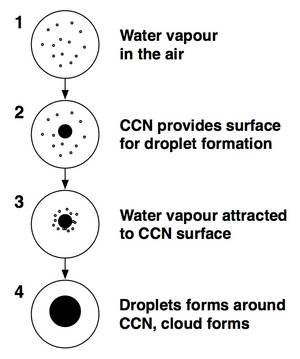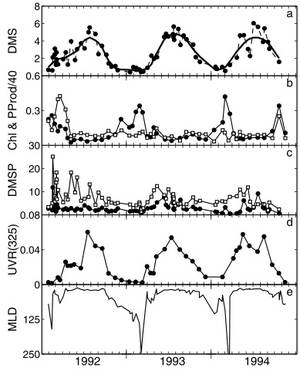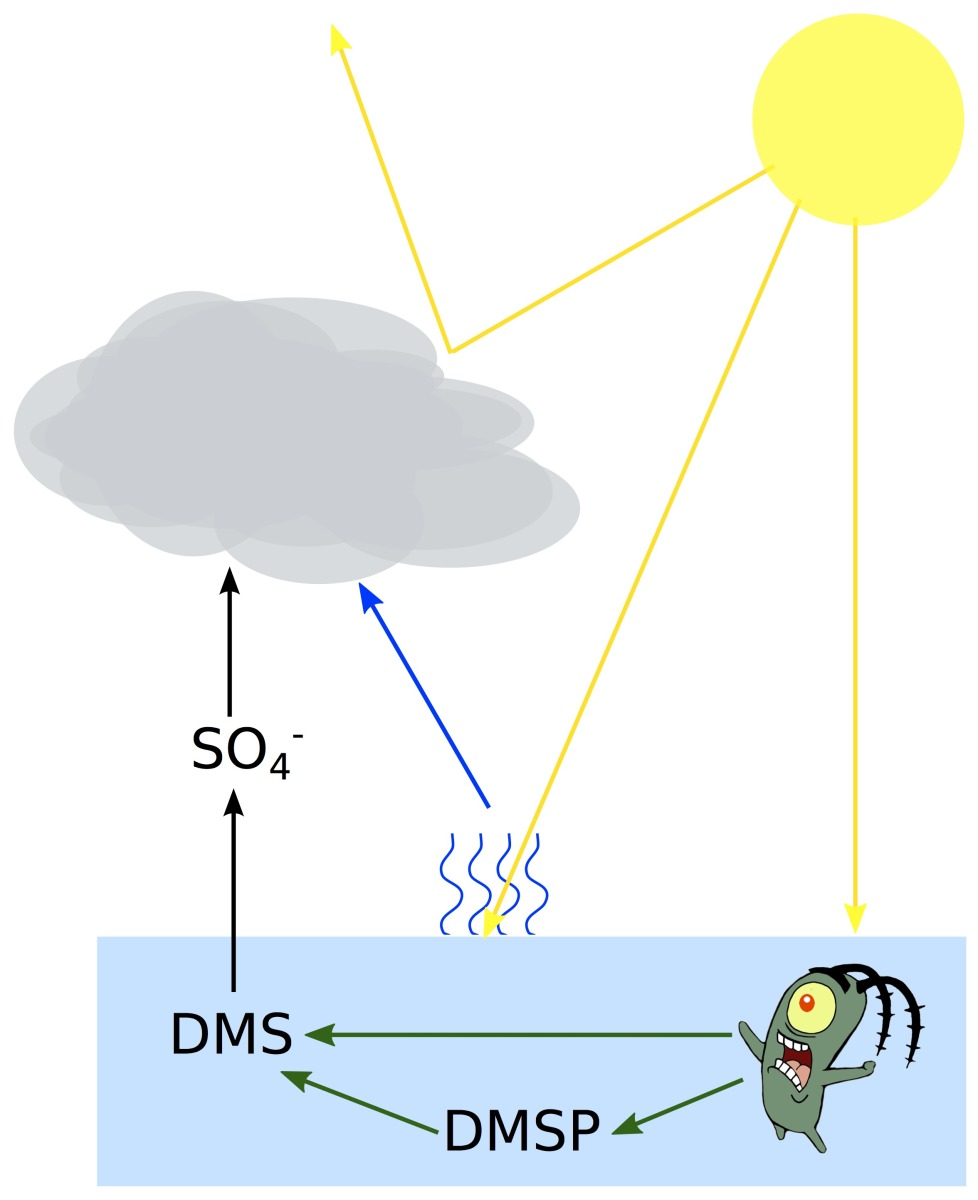The tiny plants that inhabit the ocean (phytoplankton) have developed a remarkable mechanism to protect themselves from harmful UV radiation in the bright summer months: they make clouds. This is probably the most elaborate sun-screen on the planet!

Right: A variety of plants (phytoplankton, left) and animals (zooplankton, right) that fill the oceans. The largest of the creatures in these pictures is less than 1mm long.
Over the course of the last couple of centuries we have become increasingly aware of how interconnected all the aspects of our planet are. With the development of scientific techniques and instruments in the last few decades, we have come to realise that vast regions that were thought to be barren, inhospitable deserts are in fact teeming with microscopic life. We have found life in extreme cold and extreme heat, in isolated prehistoric lakes, in the driest places, in the deepest depths of the oceans in boiling acid, and dark places deep underground. The sheer presence of this life is extraordinary, but the unexpected ways in which these microbes are connected directly to our lives boggles the mind.
We will focus here on the oceans. To think about this properly, you must put aside your perception of the seas as a vast body of clear blue water, and instead think of it as a huge bowl of microbial soup that covers 2/3 of the Earth. Every millilitre of water is home to an astonishing ecosystem of plants and animals, with as much drama and excitement as the charismatic animals on the African plains... if you had a microscope. While this analogy is contrived and ridiculous, it illustrates the constant struggle for life at all levels of the food chain - even in tiny drops of seawater there are plants capturing sunlight, grazing animals eating the plants, and voracious predators hunting down the grazers, and so on up the food chain that ultimately fuels the largest animals on the planet, the whales.
Each stage of this food chain does its utmost to survive, battling both the creatures that rely on it for food, and the natural environment. This evolutionary 'arms race' can lead to some truly astonishing connections, that are far from immediately obvious. Over the last few decades the diverse combination of satellite imaging, marine biochemistry, atmospheric chemistry and meteorology have revealed that phytoplankton can bend the weather to their advantage, seeding clouds to protect themselves from harmful UV radiation.
Cloud Seeding
Clouds are tiny droplets of water or crystals of ice suspended in the air. To form a cloud we need two things: water as a gas in the air, and something to make it condense out of the air and form droplets. As most of the world is covered in liquid water, the first is very simple - as long as there is sun, there will be evaporation, and the air will contain water vapour. There are some notable exceptions in deserts or during harsh droughts (the Sahara, or Texas in recent years), but for the most part, the air will always contain some water.
This is expressed as 'relative humidity', which you will often come across in weather forecasts. The relative humidity describes the amount of water the air can hold in its gas form at a given temperature. At 100% relative humidity, no more water can evaporate and enter the air as gas.
The second requirement for cloud formation is rather more complicated - something to push the relative humidity of the air over 100%, and bring the water droplets into the world. The most straightforward way to do this is to cool the air down. This drop in temperature reduces the energy of the water molecules. All molecules are constantly moving, and jiggling about, and the amount of energy the molecules have determines the extent of this jiggling. As temperature drops, the energy of the water molecules is reduced, they begin to slow down, and hang around long enough to stick to each other, clump together and form droplets. However, cooling alone is rarely enough to make clouds: there are major energetic barriers to this spontaneous droplet formation.
So what allows this water to remain as a gas? Simply put, the water molecules moving around in the air have a very small chance of bumping into one another, and even when they do, the amount of jiggling they do (even at low energy) means that it is very unlikely for them to stay stuck together for any length of time. Once several of these molecules have stuck together, they have a good chance of staying together and creating a droplet, but getting this initial 'nucleus' of a droplet is extremely improbable. Experiments have shown that you can cool water vapour to 400% saturation before water droplets form spontaneously like this.
Luckily for the weather, the atmosphere is far from clean. It, just like the sea, is a soup of tiny particles, small enough that they can remain floating around in the atmosphere, buoyed up by air movements and molecular forces. These particles include dust, soot, ash, sea-salt, sulphur compounds, organic molecules or even micro-bacteria. They are typically around 0.0002 mm in diameter, around one hundred times smaller than a cloud droplet, and ten thousand times smaller than a raindrop. They are everywhere - 100-1000 in very cubic meter of air, and around 2 billion tons are released into the atmosphere each year, from natural and manmade sources.
These particles provide a surface for the cooling water vapour to stick to. They remove the requirement for the extremely unlikely spontaneous combination of water molecules, and allow droplets to form much more easily. These particles are known as Cloud Condensation Nuclei (CCNs). This behaviour is exploited by physicists, who use a 'cloud chamber' to look for tiny particles in the air. If a cloud forms sooner than expected, it means that the tiny particles are present, and acting as CCNs. How soon the cloud forms can tell them something about the abundance and properties of the particles.
Left: The  basic action of a cloud condensation nucleus. Water vapour in the air (1) is influenced by the appearance of a CCN (2). They are attracted to the hygroscopic CCN surface (3), and eventually form a cloud droplet (4).
basic action of a cloud condensation nucleus. Water vapour in the air (1) is influenced by the appearance of a CCN (2). They are attracted to the hygroscopic CCN surface (3), and eventually form a cloud droplet (4).
All CCNs are not equal. Their size and chemistry has a large affect on how good they are at forming clouds. This is mainly determined by how hygroscopic they are - how good they are at hanging on to water molecules. Sea-salt and sulphates, for example, are extremely hygroscopic, while dust and soots are much less fond of water. Dust and soots find their niche in higher latitudes, where they are much better at spawning ice crystals in colder clouds than their more hygroscopic cousins. The global abundance and variety of CCNs is far from uniform, and variations in their concentration have major effects on global weather patterns.
Cloud Seeding is the process that these CCNs accomplish - allowing the water droplets to form from saturated air, without the humidity being almost impossibly high. Without this process, the world's weather would be almost unrecognisable.
With our knowledge of these processes, people are attempting to manipulate the weather. The theory is that by releasing CCNs into the air, it is possible to control exactly where and when we want it to rain. There are many cases of people trying this around the world, famously in the run up to the Beijing 2008 Olympics, where rain clouds were seeded to reduce smog and pollution in the city, and to prevent rain during the opening and closing ceremonies. They did this by firing rockets containing silver-iodide into the skies above Beijing. However, the effectiveness of cloud seeding varies, depending on who you talk to.
Plankton Reaction
From clouds, we move on now to the waters of the Sargasso sea, the North Atlantic and the Southern Ocean, which scientists have been examining with satellites and microscopes.
The tiny plants (phytoplankton) that inhabit the surface waters of the ocean go through strong seasonal cycles, controlled by the availability of nutrients and sunlight. However, it is possible to have too much of a good thing, and as the sun intensifies through spring into summer, so does the amount of harmful UV radiation that the plankton are exposed to. This UV radiation is a threat to the plankton in exactly the same way it causes sunburn in humans - UV-B radiation causes direct damage to DNA, and can turn normally harmless chemicals into highly reactive free radicals, that can wreak havoc in the cell.
So just as we reach for the sun-cream when the sun comes out, the plankton produce a compound to help with some of the harmful effects of the radiation: dimethylsulfoniopropionate, or DMSP, for short.
The DMSP produced by plankton breaks down rapidly to dimethyl sulphide (DMS) in the water. Researchers found that phytoplankton in the Sargasso sea increased DMS concentration in the water by around 8-10 times under intense sunlight, and that 77% of this increase was a direct result of the UV light. They also found that the DMS molecules were completely refreshed every 3-5 days, indicating that this production was continuing at an enormous rate throughout the UV exposure. In biological circles, this scale of production is truly enormous.
Right:  figure from Toole & Siegel (2004) showing the relationship between UV light and DMS concentration in the Sargasso sea. There is a clear correlation between UV radiation (UVR) and DMS concentration. What is really interesting about this is that DMS concentration spikes when chlorophyll concentration (indicative of how abundant phytoplankton are in the water) is at a minimum, showing that it is not just a result of having more phytoplankton in the water. The DMS spikes also coincide with a shallow Mixed Layer Depth (MLD), where the phytoplankton will be trapped closer to the ocean surface.
figure from Toole & Siegel (2004) showing the relationship between UV light and DMS concentration in the Sargasso sea. There is a clear correlation between UV radiation (UVR) and DMS concentration. What is really interesting about this is that DMS concentration spikes when chlorophyll concentration (indicative of how abundant phytoplankton are in the water) is at a minimum, showing that it is not just a result of having more phytoplankton in the water. The DMS spikes also coincide with a shallow Mixed Layer Depth (MLD), where the phytoplankton will be trapped closer to the ocean surface.
Scientists know that it is produced in response to excessive UV exposure, but there is some uncertainty surrounding exactly what it does in the cell. Some suggest it strengthens and reinforces the cell wall, helping to block out some of the UV; others have found that it breaks down to DMS when the cells are stressed, which soaks up some of the harmful free-radicals. But whatever the direct, biological effects of DMSP and DMS, the indirect effects are much more surprising, and could just as easily have driven the evolution of their production:
When UV light causes increases the production of DMSP some of it diffuses out of the cells into the water, and much more is released as the cells are eaten by grazers. Once in the water, it is quickly converted by bacteria to DMS, which is highly volatile, and leaves the surface of the ocean for the atmosphere. In the atmosphere, it is oxidised to various compounds, including sulphur dioxide, which is a potent CCN. Meanwhile, evaporation from the oceans in the hot sun has raised the humidity of the air, making it ripe for the formation of clouds. These CCNs derived from phytoplankton DMS are the only trigger this water-heavy air needs, and clouds start to form. As the clouds form and thicken, they absorb much of the harmful UV radiation that was damaging the plankton, and their DMS production slows, and this cycle continues. So by producing such incredible quantities of DMS in response to UV radiation, the phytoplankton effectively put up an enormous sunshade to protect themselves. There have also been suggestions that other chemicals (for example, isoprenes) produced by the phytoplankton can add to this effect.
Left:  A simplified version of the UV-plankton-DMS-cloud links. There are also additional loops involving the creation of airborne sulphuric acid, which then create secondary CCNs and seed further clouds.
A simplified version of the UV-plankton-DMS-cloud links. There are also additional loops involving the creation of airborne sulphuric acid, which then create secondary CCNs and seed further clouds.
Many people happily lie in the sun, scarcely remembering to apply the occasional dash of suncream. Tiny microbes have a much higher concentration of common sense, and have bent the clouds to their will to protect them from the sun!
Geo-engineering?
While these plankton certainly weren't aware of it, they have been happily carrying out a highly controversial and political process for millennia: they have been geoengineering since before we existed!
The location and timing of cloud production has profound effects on global weather patterns, controlling when and where it rains on the land, and where the good places to live are. Weather patterns have been a central factor in determining where people settled, and which bits of land they decided to fight about.
On a much longer timescale, these clouds will have helped shaped the climate of our planet, by contributing to the 'cloud albedo' of the Earth. Albedo describes the process by which light-coloured things reflect most of the sunlight energy that hits them back into space. Ice caps are a major one, and some scientists fear a 'runaway greenhouse effect', as the ice caps melt and the solar radiation they used to reflect is let in, and increases the rate of warming. The idea of albedo has also led people to suggest painting everyone's roofs and all the roads white, to alleviate rising temperatures. The clouds produced by plankton in hot weather will have contributed to the cloud albedo of the planet, and helped defined the climate we live in today.
Climate and the Future
The importance of clouds made by phytoplankton for global weather and climate control was first laid out in the CLAW Hypothesis, published in 1987 by Robert Charlson, James Lovelock, Meinrat Andreae and Stephen. This hypothesis described a negative feedback loop where plankton could help to reduce the effects of global warming. They proposed a mechanism where warmer oceans lead to more phytoplankton blooms and enhanced DMS production. This leads to more, thicker clouds and an increase in the cloud albedo, which then reduces the amount of sun energy hitting the Earth and reduces the warming. The activity of phytoplankton act to dampen the warming effect of increased CO2.
In reality, the situation in the ocean is rather more complicated. Increased warming will also cause the ocean to become more stratified, and fewer deep-water nutrients will be available to the phytoplankton living at the surface. This means that even though the water is warmer, the phytoplankton don't have the nutrients that allow them to grow, and there would be fewer phytoplankton blooms. In turn, there would be less DMS, and fewer, thinner clouds, which would decrease the cloud albedo and let more sun in, exacerbating the warming of the planet. This alternate positive feedback loop was described by James Lovelock in a later book 'The Revenge of Gaia' in 2006, and is known as the Anti-CLAW Hypothesis.
Unfortunately, since the publication of these two hypotheses, most new evidence from ocean observations, experiments and global climate models tend to favour the Anti-CLAW hypothesis, with a more stratified ocean and fewer clouds to reflect the sun. Some studies even suggest that these plankton-derived clouds have little effect on long-term climate, and are only really important for local weather patterns. On a socio-economic scale though the weather is extremely important, and it is possible perhaps that the geo-engineers will have their day, trying to maintain the current status quo of plankton cloud production: keeping the phytoplankton blooming in the right times in the right parts of the ocean to keep the weather patterns as reliable as they can.
REFERENCES:
1. Toole, D. A., & Siegel, D. A. (2004). Light‐driven cycling of dimethylsulfide (DMS) in the Sargasso Sea: Closing the loop. Geophysical Research Letters,31(9).
2. Cropp, R., Norbury, J. & Braddock, R. D. (2007) Dimethylsulphide, clouds, and phytoplankton: Insights from a simple plankton ecosystem feedback model. Global Biogeochemical Cycles, 21 . ISSN 0886-6236
3. Meskhidze, N., & Nenes, A. (2006). Phytoplankton and cloudiness in the Southern Ocean. Science, 314(5804), 1419-1423.
4. Charlson, R. J., Lovelock, J. E., Andreae, M. O., & Warren, S. G. (1987). Oceanic phytoplankton, atmospheric sulphur, cloud albedo and climate. Nature,326(6114), 655-661.
5. Lovelock, J. (2006). The revenge of Gaia: Earth's climate in crisis and the fate of humanity. Basic Books.
6. Vallina, S. M., Simo, R., & Manizza, M. (2007). Weak response of oceanic dimethylsulfide to upper mixing shoaling induced by global warming.Proceedings of the National Academy of Sciences, 104(41), 16004-16009.
- Previous The Polar Icecaps are Melting
- Next Alpha Shock










Comments
Add a comment